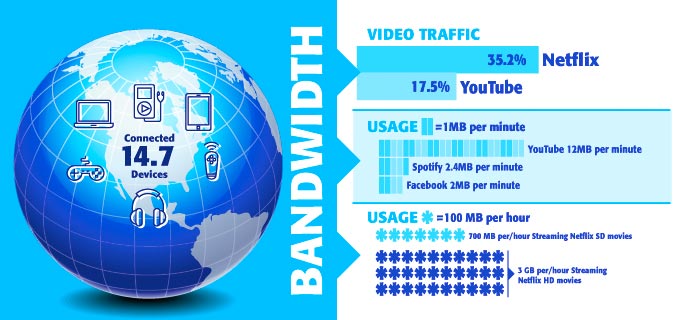
If your home is like most, it’s filled with devices that are accessing the Internet. Smartphones, tablets, laptop and desktop computers, televisions, even doorbells, lightbulbs, and refrigerators are all communicating through home Internet service these days.
According to the Connected Device Market Monitor study from intelligence company IHS Markit, every household in the world has on average four Internet-connected devices. The study includes tablets, smartphones, PCs, laptops, gaming consoles, smart TVs, smart appliances, and more. In North America, that number is even higher. The study found that on average, North American households have 14.7 connected devices.
Those devices use up a lot of bandwidth. The average monthly broadband usage in US homes is 190 gigabytes per month, according to a report from iGR Research. And that number is expected to continue to rise. iGR’s report, U.S. Home Broadband and Wi-Fi Usage Forecast, 2015-2020, predicts that average monthly broadband usage will increase substantially moving forward. Two factors are driving higher usage of broadband: more households upgrading from lower-speed DSL connections, and greater use of higher-definition video.
With some broadband providers imposing data caps, and others throttling back speeds when users reach a particular threshold, all of this gobbling of bandwidth can pose a big problem.
What’s Hogging Your Bandwidth?
We’ll give you a one-word answer: Video. According to a study by broadband services company Sandvine, during peak hours in North America, 71% of all downstream bandwidth going from providers to consumers was used up by video. They forecast that number will rise to 80% of downstream bandwidth by 2020.
Netflix sucks down the biggest share of the video traffic, with 35.2% of downstream traffic on North American networks during primetime hours. YouTube ranks second, at 17.5%.
On average, streaming an HD Netflix movie uses 3GB per hour, while streaming an SD movie uses 700MB per hour.
Downloading a rented movie, say from iTunes, is slightly less bandwidth intensive. On average, an HD movie from iTunes will use about 4GB of data, while an SD movie will set you back 1.5GB.
YouTube usage is slightly less bandwidth-intensive, but still accounts for a fair amount of usage. For example, while YouTube usage varies greatly, depending on the quality of the video you stream, figure on 12MB per minute to watch a 1080p HD video.
Streaming music is far less data-intensive than you’d think. Spotify uses just 2.40MB per minute to stream its highest quality audio (320kbps).
Other apps are even more stingy about data usage. For example, browsing Facebook uses about 2MB per minute; Skype uses just 360KB per minute; and general web browsing and email use just 7GB per month, on average.
So How Much Bandwidth is Enough?
Now that you know which types of apps use the most bandwidth, you can start figuring out just how much bandwidth you actually need.
You can start by looking seriously at what apps you use and how you use them. Do you watch a lot of movies? Binge-watch an entire television series in a week? Or do you just download the occasional movie and surf the web casually? Do some calculations based on the usage information we provided earlier, and you’ll have a rough idea of how much data you use.
With more devices than ever communicating via the Internet, it’s crucial that you understand what’s hogging all your bandwidth so you can upgrade your Internet speed package, and get the package that best fits the needs of your household.